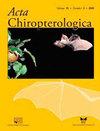Foraging Time and Temperature Affected Birth Timing of Rhinolophus ferrumequinum and Predicted Year-To-Year Changes for 25 Years in a Population in West Wales, U.K.
IF 0.7
4区 生物学
Q4 ZOOLOGY
引用次数: 0
Abstract
Movements of Rhinolophus ferrumequinum in and out of the nursery roost at Stackpole (West Wales, U.K.) were monitored automatically from 1994 to 2018 with simultaneous measurements of roost and external air temperatures. Pups were counted manually in June–July and mean birth dates calculated. Maximal foraging times of the population between 16:00 h and 08:00 h and temperatures at midnight showed three types of activity. These types of activity explained why warmer springs were followed by earlier birth dates. When April was warmer the number of degree days, linked to the activity of night-flying insects, was higher so the maximal foraging times were longer. Hence, mean birth dates were earlier due to faster gestation. The indirect effect of degree days on the birth date, measured by the partial regression coefficient (ß = -0.321), was weaker than the direct effect (ß = -0.628) and the mediating effect of maximal foraging time was significant (P < 0.001). During May–June and June–July bats foraged mainly from dusk to dawn so there was little variation in the maximal foraging times of the population, and it did not significantly mediate the effect of temperature on birth date. Birth dates were later when the external temperatures in June–July were higher (ß = 0.309), but the effect was small (R2 = 9.5%). Path analysis further revealed that longer maximal foraging times of the population in April predicted the year-to-year changes in the number of births and subsequently the number of adult females. Maximal foraging times of the population in April were a major influence on birth timing and ultimately determined whether the population grew or declined.在英国西威尔士,觅食时间和温度影响铁鼻ophus ferrumequinum种群的出生时间和预测25年的年变化
1994年至2018年,通过同时测量栖息地和外部空气温度,自动监测了Rhinolophus ferromequinum在Stackpole(英国西威尔士)苗圃栖息地内外的活动。人工统计6月至7月的幼崽数量,并计算平均出生日期。种群在16:00至08:00之间的最大觅食时间和午夜的温度显示出三种类型的活动。这些类型的活动解释了为什么春天越暖和,出生日期就越早。当四月更温暖时,与夜间飞行昆虫的活动有关的天数更高,因此最大觅食时间更长。因此,平均出生日期更早是因为妊娠更快。通过偏回归系数(ß=-0.321)测量,学位天数对出生日期的间接影响弱于直接影响(\223=-0.628),最大觅食时间的中介作用显著(P<0.001)。在5-6月和6-7月,蝙蝠主要从黄昏到黎明觅食,因此种群的最大觅食时间变化不大,并且它没有显著地介导温度对出生日期的影响。当6月至7月的外部温度较高时,出生日期较晚(ß=0.309),但影响较小(R2=9.5%)。通径分析进一步表明,4月种群的最大觅食时间较长,可以预测出生数量和成年雌性数量的逐年变化。种群在4月份的最大觅食时间是对出生时间的主要影响,并最终决定了种群的增长还是下降。
本文章由计算机程序翻译,如有差异,请以英文原文为准。
求助全文
约1分钟内获得全文
求助全文
来源期刊

Acta Chiropterologica
生物-动物学
CiteScore
2.50
自引率
20.00%
发文量
42
审稿时长
>12 weeks
期刊介绍:
Acta Chiropterologica, published by the Museum and Institute of Zoology at the Polish Academy of Sciences, is devoted solely to the study and discussion of bats.
 求助内容:
求助内容: 应助结果提醒方式:
应助结果提醒方式:


